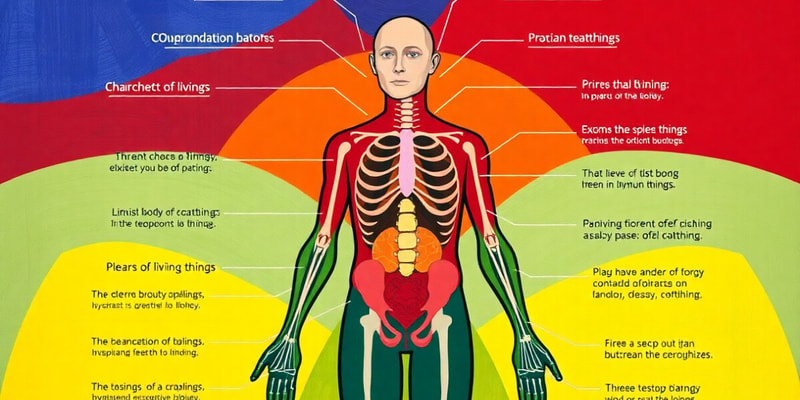Podcast
Questions and Answers
Which level of organization in the human body includes both cells and specialized subunits?
Which level of organization in the human body includes both cells and specialized subunits?
Which tissue type is primarily involved in producing movement within the human body?
Which tissue type is primarily involved in producing movement within the human body?
At which level of organization do multiple organs work together for complex functions?
At which level of organization do multiple organs work together for complex functions?
Which of the following best describes the organ system responsible for the exchange of gases, nutrients, and wastes?
Which of the following best describes the organ system responsible for the exchange of gases, nutrients, and wastes?
Signup and view all the answers
What type of tissue primarily protects and supports the body's structures?
What type of tissue primarily protects and supports the body's structures?
Signup and view all the answers
Which statement about the human microbiome is correct?
Which statement about the human microbiome is correct?
Signup and view all the answers
What percentage of the total microbiome is found in the large intestine?
What percentage of the total microbiome is found in the large intestine?
Signup and view all the answers
Which system is NOT influenced by the human microbiome?
Which system is NOT influenced by the human microbiome?
Signup and view all the answers
How does the ratio of human cells to microbial cells in the human body approximate?
How does the ratio of human cells to microbial cells in the human body approximate?
Signup and view all the answers
What type of microorganisms are included in the human microbiome?
What type of microorganisms are included in the human microbiome?
Signup and view all the answers
Which statement most accurately reflects the current research status on the human microbiome?
Which statement most accurately reflects the current research status on the human microbiome?
Signup and view all the answers
Which characteristic of living things best describes the complex arrangement of cells, tissues, and organs in organisms?
Which characteristic of living things best describes the complex arrangement of cells, tissues, and organs in organisms?
Signup and view all the answers
What process is defined as the sum of all chemical reactions within an organism?
What process is defined as the sum of all chemical reactions within an organism?
Signup and view all the answers
Which of the following metabolic processes involves the breakdown of larger molecules into smaller ones?
Which of the following metabolic processes involves the breakdown of larger molecules into smaller ones?
Signup and view all the answers
In the context of living organisms, what does growth primarily refer to?
In the context of living organisms, what does growth primarily refer to?
Signup and view all the answers
Which of the following best illustrates the concept of development in living organisms?
Which of the following best illustrates the concept of development in living organisms?
Signup and view all the answers
What is a primary function of the integumentary system?
What is a primary function of the integumentary system?
Signup and view all the answers
Which system is directly involved in blood cell formation?
Which system is directly involved in blood cell formation?
Signup and view all the answers
How does the muscular system contribute to homeostasis?
How does the muscular system contribute to homeostasis?
Signup and view all the answers
Which organ system is responsible for consciousness and memory?
Which organ system is responsible for consciousness and memory?
Signup and view all the answers
What role do hormones play in the endocrine system?
What role do hormones play in the endocrine system?
Signup and view all the answers
Which of the following systems is primarily involved in protecting the underlying tissues?
Which of the following systems is primarily involved in protecting the underlying tissues?
Signup and view all the answers
Which system stores essential minerals like calcium and phosphorus?
Which system stores essential minerals like calcium and phosphorus?
Signup and view all the answers
In which system do glands synthesize and release hormones?
In which system do glands synthesize and release hormones?
Signup and view all the answers
What is the primary purpose of using precise language in anatomy and physiology?
What is the primary purpose of using precise language in anatomy and physiology?
Signup and view all the answers
In the anatomical position, which of the following statements is correct?
In the anatomical position, which of the following statements is correct?
Signup and view all the answers
Which of the following best describes the coronal (frontal) plane?
Which of the following best describes the coronal (frontal) plane?
Signup and view all the answers
What distinguishes the midsagittal (median) plane from other anatomical planes?
What distinguishes the midsagittal (median) plane from other anatomical planes?
Signup and view all the answers
Which of the following statements about anatomical terminology is accurate?
Which of the following statements about anatomical terminology is accurate?
Signup and view all the answers
Which gland is primarily involved in regulating metabolism and growth?
Which gland is primarily involved in regulating metabolism and growth?
Signup and view all the answers
What role do lymph nodes play in the lymphatic system?
What role do lymph nodes play in the lymphatic system?
Signup and view all the answers
Which of the following structures is NOT part of the cardiovascular system?
Which of the following structures is NOT part of the cardiovascular system?
Signup and view all the answers
What function do the adrenal glands primarily serve?
What function do the adrenal glands primarily serve?
Signup and view all the answers
Which organ is essential for gas exchange in the respiratory system?
Which organ is essential for gas exchange in the respiratory system?
Signup and view all the answers
Which system includes the hypothalamus and thymus?
Which system includes the hypothalamus and thymus?
Signup and view all the answers
What type of blood vessels primarily transport lymph fluid?
What type of blood vessels primarily transport lymph fluid?
Signup and view all the answers
Which of the following is a function of the pancreas in the endocrine system?
Which of the following is a function of the pancreas in the endocrine system?
Signup and view all the answers
The central nervous system includes which of the following?
The central nervous system includes which of the following?
Signup and view all the answers
Which organ is responsible for producing sex hormones in males?
Which organ is responsible for producing sex hormones in males?
Signup and view all the answers
Which organ is NOT part of the digestive system as it is defined in the diagrams?
Which organ is NOT part of the digestive system as it is defined in the diagrams?
Signup and view all the answers
What is the primary function of the male reproductive system as illustrated in the diagrams?
What is the primary function of the male reproductive system as illustrated in the diagrams?
Signup and view all the answers
Which of the following organs is included in both the urinary and reproductive systems?
Which of the following organs is included in both the urinary and reproductive systems?
Signup and view all the answers
In female reproductive anatomy, what is the primary purpose of the uterus?
In female reproductive anatomy, what is the primary purpose of the uterus?
Signup and view all the answers
The urinary system is primarily responsible for which of the following functions?
The urinary system is primarily responsible for which of the following functions?
Signup and view all the answers
What anatomical term best describes the location of the ovaries in relation to the uterus?
What anatomical term best describes the location of the ovaries in relation to the uterus?
Signup and view all the answers
Which organ system is responsible for the absorption of nutrients and expulsion of waste?
Which organ system is responsible for the absorption of nutrients and expulsion of waste?
Signup and view all the answers
Which of the following structures is labeled as part of the female reproductive system?
Which of the following structures is labeled as part of the female reproductive system?
Signup and view all the answers
What is the primary role of the liver within the digestive system?
What is the primary role of the liver within the digestive system?
Signup and view all the answers
Which part of the urinary system collects urine from the kidneys before it is excreted?
Which part of the urinary system collects urine from the kidneys before it is excreted?
Signup and view all the answers
Study Notes
Characteristics of Living Things
- All living organisms share several distinct characteristics, including organization, metabolism, growth and development, responsiveness, adaptation, regulation, and reproduction.
Levels of Organization in the Human Body
- The human body is organized in a hierarchical manner, from the simplest chemical level to the most complex organismal level.
- Chemical level: Atoms combine to form molecules, including important macromolecules such as proteins and DNA.
- Cellular level: Cells are the basic units of structure and function in the body, with variations in structure depending on their function.
- Tissue level: Tissues are groups of similar cells working together to perform specific functions. There are four major tissue types: epithelial, connective, muscle, and nervous.
- Organ level: Organs are composed of two or more tissue types that work together for complex functions, such as the small intestine (digestion).
- Organ system level: Multiple organs work together to coordinate activities, like the digestive system (digestion, absorption, excretion).
- Organismal level: All body systems function together to maintain a healthy organism.
Introduction to Organ Systems
- The human body has 11 organ systems, each with specific functions to maintain life.
- Each system contributes to vital functions like nutrient exchange, waste elimination, and gas exchange.
The Human Microbiome
- The human microbiome is a collection of microorganisms found on and within the human body.
- The ratio of human cells to microbial cells is approximately 1:1.
- The microbiome plays a crucial role in human health, influencing metabolic pathways and impacting overall health.
Organ Systems
- Integumentary System: Provides protection, prevents water loss, synthesizes vitamin D, regulates temperature, and houses sensory receptors.
- Skeletal System: Supports and protects the body, produces blood cells, stores calcium and phosphorus, and provides sites for muscle attachment.
- Muscular System: Produces body movement and generates heat through muscle contractions.
- Nervous System: Regulates responses to sensory stimuli, controls muscles and glands, and is responsible for consciousness, intelligence, and memory.
- Endocrine System: Secreted hormones regulate growth, metabolism, and reproductive processes.
Figure 1.3 Organ Systems
- Endocrine System: Includes glands and cell clusters that secrete hormones regulating metabolism, growth, and reproduction. Key glands are: hypothalamus, pineal gland, pituitary gland, thyroid gland, parathyroid glands, adrenal glands, pancreas, kidneys, testes (male), ovaries (female), tonsils, thymus, and thoracic duct.
- Cardiovascular System: Consists of the heart and blood vessels, transporting hormones, nutrients, removing waste products, and distributing oxygen. Key components are: heart, blood vessels, nasal cavity, trachea, bronchi, and lungs.
- Lymphatic System: Transports lymph, collecting interstitial fluid and transporting it via lymph vessels. It also plays a role in the immune response. Key components are: lymph vessels and lymph nodes.
- Respiratory System: Responsible for gas exchange (oxygen and carbon dioxide). Key components are: nasal cavity, trachea, bronchi, and lungs.
- Central Nervous System: Includes the brain and spinal cord. The image shows a partial view including: brain, spinal cord, and peripheral nerves.
Figure 1.3 Organ Systems (Diagram)
- The image contains diagrams of the human body, highlighting the different organ systems, including:
- Digestive system: oral cavity, pharynx, esophagus, stomach, liver, small intestine, and large intestine.
- Urinary system: kidneys, urinary bladder, and urethra.
- Male Reproductive system: testes, scrotum, epididymis, ductus deferens, prostate gland, urethra, and penis.
- Female Reproductive system: ovaries, uterine tubes, uterus, vagina, and clitoris and labia.
- General diagram of the entire body.
Precise Language of Anatomy and Physiology
- Anatomy and physiology utilize precise language to ensure clear understanding of body structures and functions.
- Technical terminology is used to define body position, direction, regions, and body cavities.
Anatomic Position
- The anatomic position is used as a reference point for anatomical descriptions.
- An individual in the anatomic position stands upright with feet parallel and flat, arms at the sides with palms forward, head level, and eyes looking forward.
Sections and Planes
- Sections (actual cuts) and planes (imaginary surfaces) are used to visualize internal anatomy.
- Coronal (Frontal) Plane: Divides the body vertically into anterior and posterior parts.
- Transverse (Horizontal or Cross-sectional) Plane: Divides the body horizontally into superior and inferior parts.
- Midsagittal (Median) Plane: Divides the body vertically into equal left and right halves.
Directional Terms in Anatomy
- Directional terms describe the location and relative relationships of body parts.
- Anterior: Front of the body. Example: The stomach is anterior to the spinal cord.
- Posterior: Back of the body. Example: The heart is posterior to the sternum.
- Superior: Above or higher. Example: The chest is superior to the pelvis.
- Inferior: Below or lower. Example: The stomach is inferior to the heart.
- Medial: Closer to the midline of the body. Example: The lungs are medial to the shoulders.
- Lateral: Away from the midline of the body. Example: The arms are lateral to the heart.
- Proximal: Closer to the point of attachment. Example: The elbow is proximal to the wrist.
- Distal: Farther from the point of attachment. Example: The wrist is distal to the elbow.
Major Regional Terms
- The human body is divided into axial and appendicular regions.
- Axial Region: Includes head, neck, and trunk.
- Appendicular Region: Includes upper and lower limbs attached to the axial region.
Body Cavities and Membranes
- Body cavities house organs and systems.
- Posterior Aspect: Contains cranial cavity (housing the brain) and vertebral canal (containing the spinal cord).
- Ventral Cavity: Larger anterior cavity, subdivided into thoracic cavity (heart and lungs) and abdominopelvic cavity (abdominal and pelvic organs).
-
Serous Membranes: Line internal body cavities, reducing friction between organs.
- Parietal layer: Lines the cavity wall.
- Visceral layer: Covers the organ surface.
Figure 1.8 Body Cavities
- The figure presents an anatomical diagram of cavities.
Studying That Suits You
Use AI to generate personalized quizzes and flashcards to suit your learning preferences.
Description
Explore the essential characteristics that define living organisms, including their organization and fundamental life processes. Delve into the various levels of organization found within the human body, from the chemical to the organismal level.




